How To Create a Lawyer Landing Page That Converts

Understanding landing pages is an important part of understanding your SEO for lawyers strategy as a whole. Here, we’ll discuss what a landing page is and how to create one that converts.
What is a Landing Page?
A landing page is the first page your visitors see when they come to your website from an ad or a link and is designed for one single action from the user. These single actions could be submitting a form or requesting services.
Many inexperienced law firm marketers direct all ad traffic to their homepage, but that’s not recommended.
A better approach is to build a specific landing page tailored to a specific offer and experience. This technique drives business in with a targeted message that matches each user’s need.
Before You Create a Law Firm Landing Page
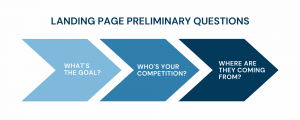
Before you even create a landing page, it’s important to sort out the following information:
What is the goal?
What should people do when they reach your landing page? Buy something? Fill out a contact form? Download an article?
Who are you competing against?
Competitor research will be critical before creating a landing page. What strategies do your competitors do? What’s their design? What can you learn from their success?
How did they get to your landing page?
A message that considers where your clients are coming from may be appropriate. If your clients found your website from an ad on Google vs. Twitter or Facebook, you may want a different landing page for each ad group. For example, if you have an ad listed on Facebook, you’ll want the landing page to be specific to Facebook.
How to Create Lawyer Landing Pages
Once you answer the above questions, you’ll be ready to create a great landing page. Here are the essential elements to include the following:

Compelling Headlines and Subtitles
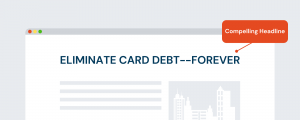
The headline or title of your landing page is basically the first impression of first impressions.
These are the words that potential clients will read before doing anything else. Believe it or not, you don’t need to use the title of your law firm as the headline of your landing page…and in fact, you shouldn’t.
Your law firm’s name and logo should appear at the top of every page, in the header on your “normal” website pages.
As for the landing page, the headline needs to command attention, explain what you do, and be limited to 20 words (preferably less than 10). Here are some examples:
Eliminate Credit Card Debt–Forever
Recoup Losses from Medical Malpractice
Collect Your Rent–On Time
These are headlines that grab attention and clearly communicate what these firms do in less than 10 words (bankruptcy, medical malpractice, and debt collection).

What follows after the headline must be a compelling subtitle. The headline grabbed their attention, but the subtitle makes them continue reading…while deepening the presentation of what your firm does. Here’s an example of an effective subtitle:
When credit card bills have become unmanageable, the way forward is easier than you think. You can retain your home, your assets, and your sanity. You can start over and rebuild your credit. We’re here to help you reclaim your life.
This subtitle could be followed by a contact form, but it could also be followed by more text elaborating on what your firm does, which brings us to our next point.
Clearly and Directly Addressing Pain Points

Not all potential clients understand “legalese”, so the copywriting on your landing page should avoid complex terms and jargon.
Sentences should not be long, and it’s better to use simpler words over a more complex lexicon (a rule we just broke).
The copywriting on your landing page is an opportunity to explain how your process works in a concise and direct way, including pain points.
Pain points address what difficulties the potential customer is going through. This is a common sales tactic, and it provides an opportunity for you to clearly share how you can help them. Here’s an example:
Without proper legal counsel, a DUI can be costly. In addition to several thousand dollar fines, offenders will have to take a series of classes that can interfere with work. They will have to turn in their license and face major restrictions on when and where they can drive.
And after is where you share how you can help:

Our firm has an 80% success rate reducing DUI fines. We have connections with DUI schools that can offer the easiest, most flexible rehab programs. With our guidance and counsel, clients won’t face a major impediment regarding when and how they can leave their homes.
Just keep in mind that for everything you write about as you address the pain points and ways you can help, the information needs to be true, something you can reliably follow through with, and follows your state’s advertising rules. (Have questions about this? Check out our state guide).
Client Testimonials

You can write everything you want about how great your firm will do, but nothing solidifies your professional appeal, such as testimonials from actual clients.
Some site builders have plugins that will allow you to connect your law firm’s website to reviews like those on Yelp, Google, Bing, and Facebook. Other site builders will require you to manually enter these testimonials.
Testimonials on a law firm website can be a tricky area to navigate. Most of your clients will not want to be mentioned by name, let alone have their picture and links to their social media accounts listed (these are best practices in most other areas of business).
However, there is an easy way around this. If your law firm is listed on reviews sites or legal directories (as it should be for local SEO), then see what people are saying there. If what they say is positive, contact them directly and ask if you can feature their words on your site.
If all else fails, you can just input the testimonials as anonymous contributions—they will still carry a lot of weight.
Design and Pictures
Think about the people you’ve met in your life and taken seriously, even if you didn’t know them well. Chances are, most of them were wearing a suit. The look of something is not just important in terms of first impressions but in terms of communicating credibility and trustworthiness.
Design
As a legal professional, design may or may not be an interest of yours. Either way, you need to locate law firm web designers who specializes in law firm website design. The look and feel of a landing page can make or break its appeal to web browsers, even if the copywriting is excellent.
You’ve got to use the right color scheme, the right font, the right size font, the right ratio of pictures to words, and the right page layout in order to communicate the vibe you’re going for as a lawyer.
For example, tropical colors and crayon-like fonts will not do wonders for your firm…but neither will a uniformly white background, Times New Roman size 12 font, and poorly-placed, pixelated pictures.
Pictures

This brings us to our next point…landing pages need to have a decent amount of pictures (although not too many).
Even for professional services such as legal advice, pictures break up the monotony of text, which can be burdensome to browsers reading on a screen.
A professional headshot of each member on your team, or some quality stock imagery can go a long way toward complementing your text and filling in the proverbial spaces between the lines
Call to Action and Contact Form
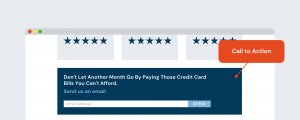
You do not want potential clients to read through your landing page and then leave without a trace. Thankfully, there are ways to keep in contact with them, and one of the easiest ways is just to collect their name and email.
This can be done by having them fill out a contact form at the end or beginning of the landing page (or even both!). While having a client call you directly is great, capturing their email gives you a permanent way of reaching out to them.
Unfortunately, some potential clients may still not be ready to work with you. They may want to shop around a little bit before settling down and calling or emailing.
To that end, you might want to incentivize your email collection process.
This can be done by offering everyone who inputs their email a free consultation call (which may be your practice anyway) or a free eBook about whatever type of law you practice.
Of course, you’ll also want to have your contact information such as a phone number, directly available so clients can just call you.
However, in order to convert successfully, it should still be associated with a call to action phrase, such as
Don’t let another month go by paying those credit card bills you can’t afford…call now!
SEO for Lawyers: How Law Firm Sites can Help
You can invest lots of work or money paying someone else to do the work in SEO for your law firm. But if clients come to your landing page and are not compelled to seal the deal, all your work is wasted.
To that end, remember that optimized landing pages are set up to convert browsers into clients. With a few simple practices that leverage sales, psychology, web design for law firms, and common sense, you can create a landing page that converts
Did you like this post? Here are some others you might enjoy:

Search Engine Optimization (SEO) has become a critical tool for law firms to stand out. It drives more visitors to…
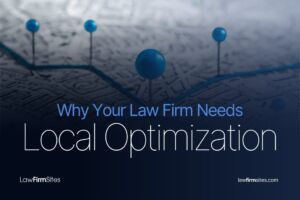
It’s easy to forget that every business is a ‘local’ business to someone. This is especially true for legal firms and attorneys who often…
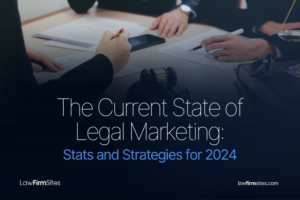
The legal industry is constantly evolving, and law firms need to stay up to date with the latest digital marketing…

